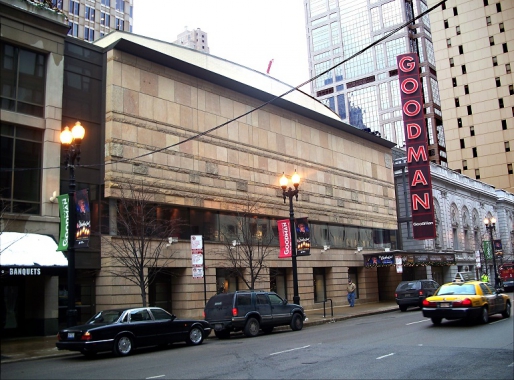An interview with Seth Bockley, director of Roberto Bolaño's 2666 at the Goodman Theatre of Chicago, by Gregory Mion (20/05/2016)

Credits : Michael Minn.
 French version of An interview with Seth Bockley, director of Roberto Bolaño's 2666 at the Goodman Theatre of Chicago.
French version of An interview with Seth Bockley, director of Roberto Bolaño's 2666 at the Goodman Theatre of Chicago. 2666 in the Zone (texts in French and Spanish).
2666 in the Zone (texts in French and Spanish).From 6th February to 20th March 2016, the Goodman Theatre of Chicago has scheduled a very haunting stage adaptation of 2666, now the legendary novel of Roberto Bolaño since it has raised a lot of subjugated critics and theories around the whole world. The making of this play has been led by Robert Falls, a major fixture of the Goodman Theatre for three decades, and by Seth Bockley, a young and talented stage director in his thirties. A friend of mine and I were very lucky to attend the play on 12th February. A bit later, we have exchanged opinions with Mr. Falls and Mr. Bockley, but we felt the necessity to complete this unceremonious meeting with further investigations. It is now done since Seth Bockley has been kind to address the questions I sent to him soon after the last representation. So I want to give warm thanks to Seth Bockley for his receptiveness and his sense of detail. Our correspondence revealed a sort of madness every “fanatic” of Bolaño’s work shares – the passion to dissect endlessly a masterpiece of literature.
Nota bene : the five parts of the play mentioned by Seth Bockley match with the five parts of the novel.
Gregory Mion
After nearly two months performing 2666, how do you evaluate the show and how did the audience react to it in general ?
Seth Bockley
The show was an extraordinary success in terms of audience reaction. I did not expect this piece to be embraced by such a wide swath of the public. Frankly we did not quite know who our audience would be for such an unusual project. In the end, we found that the play appealed to a wide range of artists and non-artists, theater fans and those who rarely attend theater. It certainly required a sense of adventure and an open-minded attitude, but we found that the play found its way into almost all of our audience’s minds and hearts. Virtually all audience members stayed through to the end (which took place after midnight most performances), and many standing ovations served as testament to the sense of satisfaction they experienced.
What I found most wonderful was the sense that the piece served the Bolañophile audience equally to the audience that had never read a word of his fiction. Every night of performance there were “superfans” in attendance who scrutinized the play for every nuance and allusion to the source novel, but very often those Bolaño “superfans” brought with them spouses or friends for whom this was their first exposure to 2666. I loved talking to those couples (one person familiar with the book, one person innocent) during each intermission to see how their experiences compared. Very often they were eager to hear each others’ opinions and reflect on how the story had been altered or preserved, as well as how it felt to experience it for the first time.
On an artistic level, I felt that the show succeeded very well as a synthesis of design and adaptation. I was very proud of the work we did in reducing the massive novel to “only” five and a half hours, and of the work the designers did to capture the sensation of living inside the book. It was through a synthesis of sound, scenery, costume, lighting and video that we were able to invoke the austere and impersonal (yet humorous and absurd) world of the Academics for Part 1 ; the intimate, warm, detailed and melancholy world of Amalfitano’s home and mind in Part 2, and so on. Without the work of the designers I don’t think the piece would have had the emotional weight and effectiveness that it did.
Audiences often picked a “favorite” part which I think is natural in a show of this sort. Most had a preference for parts 1, 3 or 5. I think it’s understandable that Part 4 was not often regarded as a “favorite” part but most audiences seemed to appreciate it despite the insistent repetitive brutality of the text and situations. Many audience members took away from the play a great affection for some of the principal and minor characters, in particular : Lola in Part 2, Oscar Fate in Part 3, Lalo Cura in Part 4, and Hans Reiter in Part 5. These characters more often than the others seemed to ‘land’ with audiences. Several people told me they hoped Oscar would come back in Part 4, for example, and many told me they felt that Lalo’s death at the end of Part 4 (a liberty we took with the text; he does not die in the original novel) was very powerful. In general, I felt the production was very successful. There is very little if anything I would want to change.

Gregory Mion
Do you envisage another adaptation of Bolaño after the adventure of 2666 ? Is there any possibility to see a revival of 2666 on stage elsewhere in the US, or even somewhere in the world ?
Seth Bockley
Neither of us are planning to work on another Bolaño adaptation in the near future. We would love to see the play remounted elsewhere, although there aren’t current plans to do so. There is certainly interest in the text and the project and we have had many conversations with producers and other theaters, but nothing (yet) to report in terms of concrete plans.
Gregory Mion
Quite a few critics have insisted on the lengthiness of the play; though a novel such as 2666 would definitely have required there to be a few additional scenes. If this had been possible, which aspect of the book would you have liked to develop further ?
Seth Bockley
Personally I would have loved to explore Part 5 a bit further, in particular the story of Boris Ansky, a long digression in the novel that we eliminated in our production because we felt it did not play well as drama (especially in the fifth hour of performance). It is a challenging section to adapt especially as it is VERY literary and reflexive in nature. Additionally, the later parts of Hans Reiter’s life and his connection with Mrs. Bubis in Part 5 could have borne more emphasis and development, but again we decided to cut this down to a minimum in favor of a more streamlined and propulsive action for the final section. I would also have loved to develop a little further the interior space of Amalfitano’s mind in Part 2. I like the way our version of Part 2 tells the story of a family (Oscar, Rosa and Lola) but I feel we didn’t have a chance to explore Amalfitano’s profound philosophical fixations, deep madness, and his questions of sexuality and homosexuality that play such a prominent part in the novel. I imagine there might be a 6 or 7 hour version of the play that could investigate such possibilities. And yet I am left with the feeling that our production was appropriate in length and perhaps exactly as it should be.
Gregory Mion
Did you make something special during or after the very last performance ?
Seth Bockley
There was a wonderful celebration after the last performance. The actors were very emotional and so were we. We are theater people after all !
Gregory Mion
How did the stage direction of 2666 have progressed from early February to late March ? Which modifications have been the most significant ?
Seth Bockley
Very little changed. In the first days of performance (the “preview” period) we did make several adjustments to the staging, design and even to the text. For example, in Part 1 we added Amalfitano’s speech about the necessity of reading messy ambitious literature (“when the great writers struggle against that something that terrifies us all, that something that spurs us on, amid blood and mortal wounds and stench.”), which had not previously been present in performance. This was one of the most significant changes. Most of the rest of the alterations were minor adjustments to text, staging or performance.
Gregory Mion
Does some members of the audience have proclaimed any unpleasant remarks ? More specifically, which critics have been the most helpful ?
Seth Bockley
Once we opened the show, we did not have the opportunity to respond to any specific criticism from the audience apart from questions of audibility/clarity and specific acting emphasis. However, in the initial “preview” performance period, we did have the opportunity to learn from the general experience of the audience – what sections and individual lines of dialogue worked or suffered from a lack of clarity or emotion, etc. We were able to make many small but important adjustments in those initial days.
Later in the run, from my perspective, the main critical responses to the play were matters of taste – some sections 'worked' for certain audience members more than others. We listened to many opinions however and were left with the impression that the production was extremely powerful for most, and if there were critiques of the work as a whole, they often pertained equally to the original novel of Roberto Bolaño. For example, a few audience members complained about the “machismo” of the first three sections – the sense that the female characters of Liz Norton, Rosa Amalfitano and Rosita Méndez were primarily seen as sexual objects and/or victims by the principal male characters. We attempted to address these concerns in our adaptation but that reaction has some validity in my opinion for both our production and for the original novel. I felt that our choice of placing the litany of murders in Part 4 in the mouths of a female chorus went a certain way towards addressing the feminist critique, but it is certainly still an open question.
Gregory Mion
We have learned that Roberto Bolaño’s family went in Chicago to attend the play. How was their overall feeling about it ?
Seth Bockley
Carolina (Roberto Bolaño’s widow) and Lautaro (their son) had a wonderful time. Lautaro came to see it a second time. Both of them spoke at length about their appreciation for the work we did. Carolina spoke to me about the evident and profound “love” she felt in the adaptation. Rather than a play imposed onto a text, they felt this was a truly “faithful” and profoundly affectionate production, that allowed them to see their loved one’s work in a new light.
Gregory Mion
Which part of 2666 has been the most difficult to stage ?
Seth Bockley
In a sense parts 3 and 4 were the most difficult to stage. Part 3 was difficult because the original text and narrative has a propulsive energy that feels like an action movie – it’s full of “jump cuts” and sudden appearances by strange menacing characters, almost like a Tarantino or Lynch film. Because we chose to eliminate any “direct address” (the characters never speak to the audience) we had to represent Oscar Fate’s story using a “film noir” aesthetic while limited by the techniques of naturalistic theater. We solved some of these problems by interpolating video technology and filmed sequences. These allowed us to shift locations in surprising ways (using the interior of a car for an intimate scene, for example) and they also allowed us to preserve the surprising fragmentation of the original text. Part 4 was difficult for similar reasons, and because it is the longest chapter of the book with hundreds of named characters, we had to carefully “boil down” to a limited cast of characters (policemen in particular) who could shoulder the burden of the “action”. I use quotations around the word “action” because part of the challenge of staging Part 4 is to represent inaction, the inability of the detectives to solve the crimes, the relentless repetitive futility of their half-efforts. In the end I believe that Walt Spangler’s scenery that combined police desks with mounds of sand and earth served to help unify this section, and the presence of actor Nicole Wiesner as an unnamed nude corpse throughout this part completed the horrific tableau.
Gregory Mion
Did the actors make any improvisation or did they always follow the script on a strictly basis ?
Seth Bockley
The actors followed the script very carefully and strictly. In the rehearsal process they would sometimes engage in brief moments of improvisation, but these too became scripted and in the end the play was virtually identical in terms of text every night.
Gregory Mion
Which difficulty has been the most difficult to overcome for the actors ?
Seth Bockley
I believe that the biggest difficulty for the actors was to maintain energy and focus throughout the performance. Several of the fifteen actors had periods of intense and frenetic activity featuring hundreds of lines and rapid costume changes, followed by an hour of waiting, and then another huge sequence, followed by more waiting, then a wild final act that included precise scenic choreography, wigs, combat, dancing and Eastern European accents. This amount of material spread out over 5 and a half hours was challenging to retain and maintain. Many of the actors developed elaborate (nearly superstitious) rituals including when they ate food or drank water or even exercised during the performance, all with the aim of maintaining focus. Finally, some of the actors felt so highly energized after the show that they reported difficulty falling asleep (despite the late hour). This is perhaps where a judicious application of alcohol in the form of a glass of wine helped them relax and rest (and get ready to do it all again the next day).
Lien permanent | Tags : littérature, critique littéraire, théâtre, 2666, roberto bolaño, seth bockley, robert falls, goodman theatre, gregory mion |  |
|  Imprimer
Imprimer